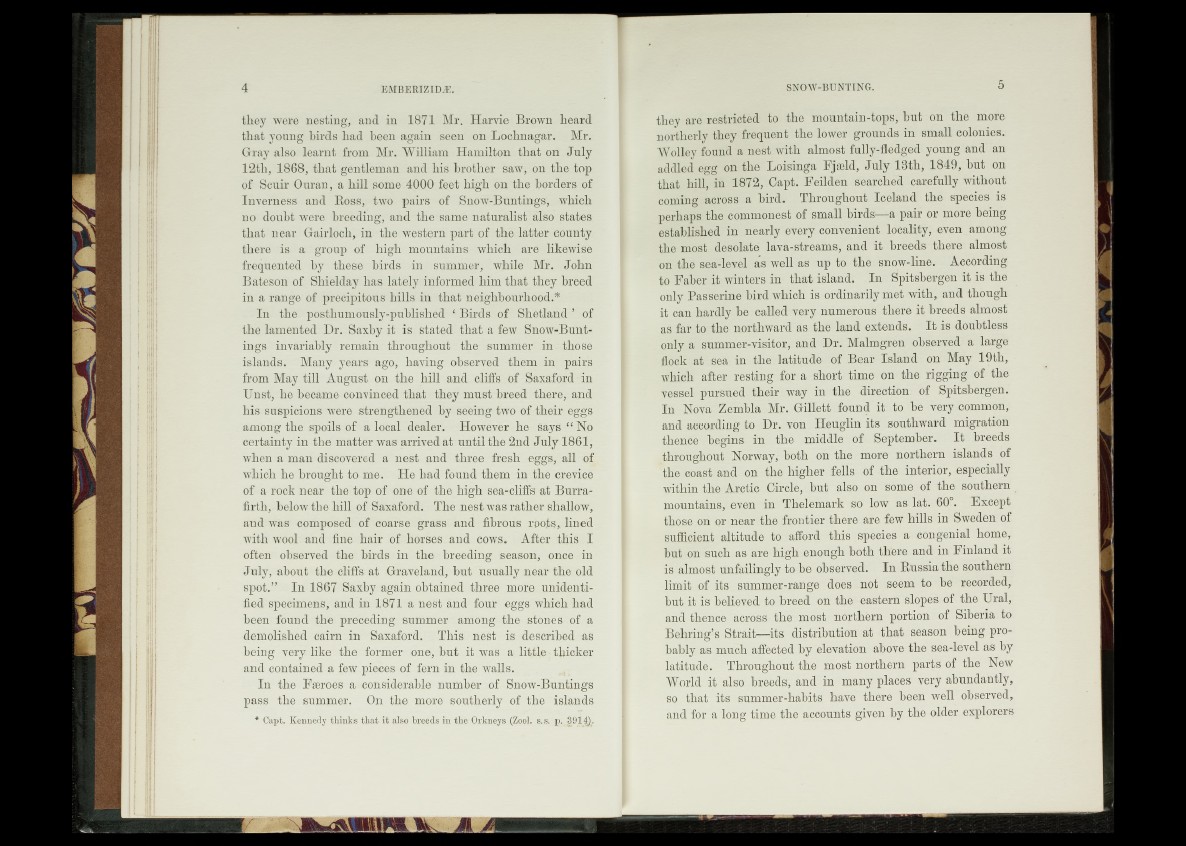
they were nesting, and in 1871 Mr. Harvie Brown heard
that young birds had been again seen on Lochnagar. Mr.
Gray also learnt from Mr. William Hamilton that on July
12th, 1868, that gentleman and his brother saw, on the top
of Scuir Ouran, a hill some 4000 feet high on the borders of
Inverness and Ross, two pairs of Snow-Buntings, which
no doubt were breeding, and the same naturalist also states
that near Gairloch, in the western part of the latter county
there is a group of high mountains which are likewise
frequented by these birds in summer, while Mr. John
Bateson of Shielday has lately informed him that they breed
in a range of precipitous hills in that neighbourhood.*
In the posthumously-published 4 Birds of Shetland ’ of
the lamented Dr. Saxby it is stated that a few Snow-Buntings
invariably remain throughout the summer in those
islands. Many years ago, having observed them in pairs
from May till August on the hill and cliffs of Saxaford in
Unst, he became convinced that they must breed there, and
his suspicions were strengthened by seeing two of their eggs
among the spoils of a local dealer. However he says “ No
certainty in the matter was arrived at until the 2nd July 1861,
when a man discovered a nest and three fresh eggs, all of
which he brought to me. He had found them in the crevice
of a rock near the top of one of the high sea-cliffs at Burra-
firth, below the hill of Saxaford. The nest was rather shallow,
and was composed of coarse grass and fibrous roofs,, lined
with wool and fine hair of horses and cows. After this I
often observed the birds in the breeding season, once in
July, about the cliffs at Graveland, but usually near the old
spot.” In 1867 Saxby again obtained three more unidentified
specimens, and in 1871 a nest and four eggs which had
been found the preceding summer among the stones of a
demolished cairn in Saxaford. This nest is described as
being very like the former one, hut it was a little thicker
and contained a few pieces of fern in the walls.
In the Faeroes a considerable number of Snow-Buntings
pass the summer. On the more southerly of the islands
* Capt. Kennedy thinks that it also breeds in the Orkneys (Zool. s.s. p. 8914)_.
they are restricted to the mountain-tops, hut on the more
northerly they frequent the lower grounds in small colonies.
Wolley found a nest with almost fully-fledged young and an
addled egg on the Loisinga Fjseld, July 13th, 1849, but on
that hill, in 1872, Capt. Feilden searched carefully without
coming across a bird. Throughout Iceland the species is
perhaps the commonest of small birds—a pair or more being
established in nearly every convenient locality, even among
the most desolate lava-streams, and it breeds there almost
on the sea-level as well as up to the snow-line. According
to Faber it winters in that island. In Spitsbergen it is the
only Passerine bird which is ordinarily met with, and though
it can hardly be called very numerous there it breeds almost
as far to the northward as the land extends. It is doubtless
only a summer-visitor, and Dr. Malmgren observed a large
flock at sea in the latitude of Bear Island on May 19th,
which after resting for a short time on the rigging of the
vessel pursued their way in the direction of Spitsbergen.
In Nova Zemhla Mr. Gillett found it to he very common,
and according to Dr. von Heuglin its southward migration
thence begins in the middle of September. It breeds
throughout Norway, both on the more northern islands of
the coast and on the higher fells of the interior, especially
within the Arctic Circle, hut also on some of the southern
mountains, even in Thelemark so low as lat. 60 . Except
those on or near the frontier there are few hills in Sweden of
sufficient altitude to afford this species a congenial home,
but on such as are high enough both there and in Finland it
is almost unfailingly to he observed. In Russia the southern
limit of its summer-range does not seem to he recorded,
hut it is believed to breed on the eastern slopes of the Ural,
and thence across the most northern portion of Siberia to
Behring’s Strait—its distribution at that season being probably
as much affected by elevation above the sea-level as by
latitude. Throughout the most northern parts of the New
World it also breeds, and in many places very abundantly,
so that its summer-habits have there been well observed,
and for a long time the accounts given by the older explorers